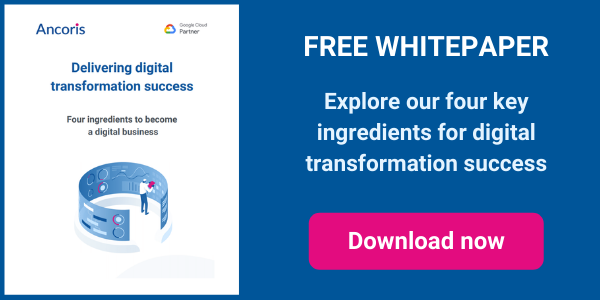Many frontline workers have been left behind by corporate IT. They’re still using inefficient and slow paper-based systems — even though the most effective digital transformation projects often involve digitising these processes. By digitising paper processes for mobile workers, you can:
Increase the efficiency of each worker
Providing employees with faster access to data about jobs, customers and customer sites, as well as relevant reference materials, can shorten site visits by up to 30%. Integrating a job app with a mapping solution lets you direct workers to their next job by the fastest route, so less time is wasted on travelling. The net result: mobile workers can complete more jobs in each shift.
Improve customer service
As well as giving mobile workers fast, easy access to all the information they need to deliver services, a well-designed app helps them record information about their visit more quickly and accurately, while customer records can be updated immediately.
There’s no need to wait for data from paper forms to be entered, so customers receive results and reports more quickly. And it’s easier for customers to audit services, especially if that involves external regulators inspecting sites and installations alongside field workers, because customer data is always up to date.
Deploy your workforce more flexibly
Workers no longer need customer-specific knowledge to be able to deliver the same quality service. Instead, any worker can support any customer, no matter how complex, because they have all the data they need to serve them. You can also update schedules throughout the day, allocating workers to new high-priority tasks or re-allocating work if a site visit takes longer than expected.
Improve employee satisfaction
You can do this by giving mobile workers tools that match the way they work and help them do their jobs more easily, more quickly and to a higher standard.
Gain competitive advantage through innovation in products and services
Processes can be redesigned to support improved communication and collaboration, enable end-to-end ecosystems incorporating IoT devices, or allow customers to explore and analyse their data through self-service portals.
Reduce your costs and minimise travel times
Digitising paper processes will reduce the headcount needed for data entry, lower your printing and stationery costs, and minimise travel time and fuel costs for mobile workers.
Game-changing technology
If the benefits of applying digital transformation to frontline workers are so obvious, why have mobile workers been neglected for so long? The answer is that, until recently, the available technologies were either impractical — getting in the way of workers doing their jobs — or too expensive to deploy and support for remote workforces of hundreds or thousands.
All that is changing, thanks to five key technologies:
- low-cost Android devices in a number of form factors, including phones and tablets. Not only are they inexpensive to deploy initially but they offer a low TCO compared to traditional field worker solutions like PDAs, because they’re easy to manage and support remotely.
- cloud-based development tools that allow secure, scalable and feature-rich custom mobile apps to be quickly developed and deployed. These custom apps can:
- integrate with team productivity tools like email, calendar and CRM systems
- access and update data in line-of-business solutions, whether running in the cloud or in traditional data centres
- incorporate functions from off-the shelf apps to handle tasks such as scanning barcodes, taking readings from wireless devices, or drafting floor plans
- mapping and location intelligence solutions that can optimise workers’ schedules and travel time and help them locate where they need to go once they arrive. Using their mobile device, workers can access the list of jobs for the day and see the best route to take to their next job given current traffic conditions. Once they arrive, they can be guided to the exact locations on a site where the work is to be done, saving them even more time.
- machine learning capabilities, which have a host of applications. For example, natural language processing means technicians whose hands are busy can listen to instructions or record test results using their voice. Image recognition can help them identify what they’re looking at: a pest control technician confronted with an unfamiliar pest, for example.
- data analytics and visualisation tools that can add value to the data in custom apps, giving workers immediate feedback or drawing attention to issues that need their attention. Heat maps, for example, can show if problems are clustered in a particular location, so a technician can look for a root cause.
Steps to digital transformation
Of course, technology is only one element in any digital transformation project, along with people and process. To increase your chances of success when tackling the particular challenges of mobile workforce management, here are 5 key steps to take:
- Find a high-level sponsor from the business who can explain to workers why they're being put through this change, address their concerns and encourage their input on making the transition as easy as possible. An effective sponsor is key to any project, of course, but especially one involving frontline workers who may not have previously used any kind of corporate IT.
- Pay close attention to the user experience. Understand your users, how they work at the moment, and how you could make their work easier and faster in future. Involve a core group in thinking about those issues and in designing and testing how they’ll interact with the app and its interface.
- Create an appropriate change management programme. Change management is about moving your users from their current environment and way of working to being productive and effective in a new environment, as quickly and seamlessly as possible. You change management programme should start as soon as you start planning the project, be tightly integrated with your technical plan and include communication and internal marketing programmes to create buy-in for the change, as well as go-live training.
- Choose the right device. A tablet may offer your developers more screen real-estate, but could get in the way when frontline workers are trying to do their job. In that case, you need to develop for mobile phones. You also need to consider issues like battery life and charging times, connectivity, and the wider ecosystem of apps that you’ll be able to build on.
- Adopt an agile approach to application development. Agile development helps you stay close to users’ needs and build apps that fit seamlessly into their workflow, by ensuring you’re constantly reviewing requirements and delivering features incrementally. It will also help you to create an app that fully supports all core tasks from the outset, with no gaps that require frustrating manual workarounds. You can always add extra nice-to-have features later.
Focusing on these key areas here at Ancoris has allowed us to work with businesses like yours to create numerous award-winning solutions for mobile workers.
Working with our digital transformation specialists
If you're involved in the busy day to day and your teams have been working with a process a certain way for years, it can be hard to step back to imagine doing it in a totally different way.
Got an idea to transform your business and want help bringing it to life? We’re all ears. We design, build and manage customised mobile and cloud apps to meet your specific needs – either alongside your team or for you. Our early prowess in mastering APIs led to Google itself becoming a customer and us building their Exam Platform. So not only do we know our onions but you can trust us to deliver innovation and edge in spades.
If you’d like to find out more about how we can help you with your own digital transformation journey, why not take a look at some of our customer success stories or talk to our Digital Transformation Specialists.

